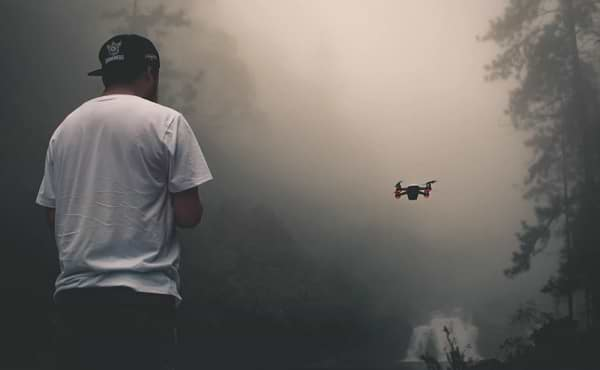
Flying a drone is extremely fun, and you just want to keep doing it no matter the weather outside! But should you fly your drone in the fog?
You can fly your drone in the fog as long as you turn off your drone’s sensors otherwise small water particles may confuse your drone which could cause a flyaway. That said, the drone pilot also needs to maintain a visual line of sight, otherwise, according to the FAA, it would be considered an illegal drone flight.
Keep reading to find out more about the legalities surrounding flying your drone through fog.
What Are The Legalities of Flying a Drone in Fog?
Flying a drone in fog is amazing and as visually pleasing as it gets, but there are a few issues that surround this activity (understandably so)!
As I mentioned above, the FAA (Federal Aviation Administration) has no specific rules and regulations that say you are not allowed to fly your drone in the fog. However, the FAA does have other rules and regulations that you might be breaking if you attempt to fly a drone in the fog.
Here are the rules and regulations you might be breaking when flying in fog:
- You are required to always maintain a visual line of sight with your drone at all times during your flight, or in visual line of sight of an observer.
- Do not operate your drone in a careless or reckless manner.
When flying your drone in foggy weather you might not break these two rules but there is a very high chance that you might, considering the circumstances and how unpredictable the weather can be.
It can become foggy out of nowhere, and the fog can also become a lot worse while you are flying. This is why flying a drone in the fog is very unpredictable and dangerous.
On a regular clear day, there are many drone rules and regulations that a pilot must follow.
Here are some of the FAA drone rules for recreational pilots:
- Register your drone with the FAA.
- Only fly for recreational purposes.
- Always fly your drone below 400 feet above the ground when you are flying in Class G airspace.
- When flying in controlled airspace(Class B, C, D, and E), you need to obtain authorization first.
- Do not fly your drone at night unless your drone is equipped with lighting that allows you to see its location at all times.
- Do not interfere with human-crewed aircraft.
- Never fly your drone under the influence of drugs or alcohol.
- Do not fly over moving vehicles.
- Do not interfere with emergency response efforts.
But if you are going to try to fly your drone in the fog, what can you do to make the flight safer for the drone, and legal for you to fly it? Keep reading to find out!
How To Make Your Drone More Visible in Fog
The biggest problem with flying a drone in foggy weather is the lack of visibility you will have in the air. There is a chance that you will lose sight of your drone depending on the thickness of the fog you will be flying in.
So as a responsible pilot you should first consider not risking flying your drone in the fog.
But if you are going to fly a drone in foggy weather, you need to find measures that will allow you to maintain a visible line of sight with your drone. One way to do this is by improving the lighting system and adding anti-collision to your drone, making it more visible while in the fog.
If you’re wondering why these tweaks are so important, then keep reading to learn why this is so necessary and how it can help you better fly your drone, no matter the conditions!
Should Your Drone Have Anti-Collision Lighting Before Flying In Fog
Visibility
The drone anti-collision lighting will help you see the drone better while it is passing through the fog.
Your drone should have built-in drone lights, but these lights are almost non-existent during the day and are also not very visible at night, fog acts as a smokescreen and makes it hard for these lights to be visible.
Anti-collision lights are bright and they make it a lot easier for pilots to spot their drones.
Avoiding Legal Consequences
One thing you need to remember is that when you fly through the fog, it becomes tough to see where your drone is located, and once your drone gets a few hundred feet in the air, it will be a lot harder to see it.
If you happen to lose sight of your drone while in the air, what could happen could land you in some serious legal trouble! You could end up crashing your drone and completely destroying it, or even worse, you could end up crashing it and really hurting someone.
It Protects Others
Anti-collision drone lights are not only there to help you locate your drone in low visibility scenarios, but also a big help for anyone that might be nearby you at the time.
It also helps others so they can also spot your drone in the sky. Whether they are civilians, authorities, or another pilot, they need to be able to see your drone too, even in the fog.
There are various types of anti-collision lighting systems and it is difficult trying to choose between which system to attach to your drone, so here’s a little help!
Tips For Choosing Anti-Collision Lighting When Flying In Fog
Consider The Weather
What kind of weather you will be flying in is important when choosing the lights to attach to your drone. You need good lights if you are going to be flying in the fog, as your lights need to be strong in order to penetrate the fog for visibility.
You should not forget that fog also consists of tiny water droplets and that could damage your lights if they can’t handle a little water. Your drone might be able to handle the water droplets and continue flying, but if your lights can’t then you need to find better lights.
The Number of Lights
Another thing you need to consider when choosing lights is how many lights you are going to need.
You need to consider this because some drones are shaped differently and therefore you might need to get at least two lights to make sure the light is spread out evenly.
The Battery
How they are powered is very important. Some of these lights draw power from the battery, which means it could heavily affect your flight time.
Some anti-collision lights use portable LiPo batteries that can be recharged. I personally feel like these are better because they are LEDs which means they last longer.
It also helps that they are rechargeable after being used is a bonus. They also don’t affect the battery life of the drone.
How to Protect Your Drone in Fog
Because the fog is made up of small water droplets, your drone may be affected by this. If your drone isn’t protected or can’t handle the water within the fog, then it could end badly and your drone could be damaged in the process.
Many pilots who have tried to fly through the fog in the past have had various problems, such as their cameras fogging up and not defogging after they have exited the fog.
Another reason why a drone flying through fog is dangerous for the drone is that the underside of the propellers frost up due to pushing air for propulsion. This causes the propellers to stop spinning and the drone can just plummet to the ground.
However, there are ways to stop this from happening, so keep reading to find out.
Drone Waterproofing
If you live in an area where it’s constantly raining, misty, or foggy, then you’ll probably need to waterproof your drone.
This might be even a good idea if you fly out over long distances, and you’re worried about getting caught in some fog.
You have two options for waterproofing:
- You could purchase some drone conformal silicone coating.
- You can also purchase a drone wet-suite.
Final Thoughts
While it is not impossible to fly your drone in foggy conditions, it is certainly not recommended, especially if you are inexperienced. If you must fly your drone in the fog, make sure you take the above precautions into consideration, and make sure your drone is fitted with the right gear to handle the fog without losing sight of it or crashing.
